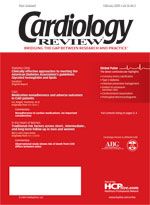Combination therapy for mixed dyslipidemia in an elderly man with diabetes
A 68-year-old man with type 2 diabetes and no history of coronary heart disease presented to a diabetes clinic.
A 68-year-old man with type 2 diabetes and no history of coronary heart disease presented to a diabetes clinic. His medications included an angiotensin-converting enzyme inhibitor, aspirin, and metformin. A hemoglobin A1C, comprehensive metabolic panel, lipid panel, and inflammatory level tests were performed. The patient had a hemoglobin A1C of 7.3%, a glucose of 131 mg/dL, a creatinine of 0.7 mg/dL, and normal liver function tests. He was also determined to have mixed dyslipidemia (total cholesterol = 215 mg/dL, LDL-C = 121 mg/dL, VLDL-C = 63 mg/dL, HDL = 31 mg/dL, and triglycerides = 317 mg/dL) and elevated inflammatory markers (hsCRP = 3.90 mg/L and Lp-PLA2 = 348.9 ng/mL). In an effort to control his abnormal lipid and inflammatory biomarker levels, the patient was started on a regimen of 20 mg of simvastatin and 160 mg of fenofibrate.
After 3 months of treatment, the patient returned to the clinic for evaluation. His lipid and inflammatory biomarker levels had greatly improved: total cholesterol, 150 mg/dL (-30%); LDL cholesterol, 81 mg/dL (-33%); VLDL cholesterol, 30 mg/dL (-52%); HDL cholesterol, 39 mg/dL (+26%); triglycerides, 148 mg/dL (-53%); hsCRP, 1.99 mg/L (-49%); and Lp-PLA2, 221.9 ng/dL (-36%). A safety evaluation showed that the patient was not experiencing abnormal muscle aches and did not have elevated creatine kinase levels or liver function test abnormalities. The patient was to continue on therapy and return to the clinic in 6 months for monitoring.
Diabetes and inflammation have been shown to influence the development of atherosclerosis. Statins and fibrates reduce inflammatory biomarkers; however, the effect of a statin and fibrate combination has yet to be elucidated. In the patient described in this case report, combination therapy positively affected hsCRP, Lp-PLA2, and lipid levels safely and effectively. The ability to adequately decrease inflammatory markers while controlling atherogenic dyslipidemia in patients with diabetes may be critical. The potential for positive cardiovascular benefits with combination therapy should be further evaluated in this high-risk population.
